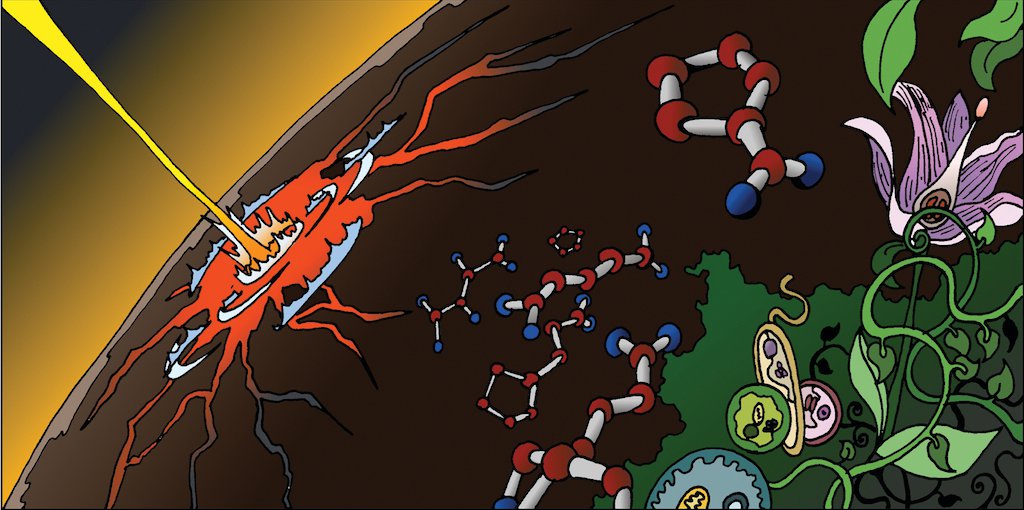Grades 9-12 or Adult Sophisticated Learner
As we search for possible life beyond Earth, it’s important for us to consider what exactly life is. It turns out that it’s not as easy to define life as you might think, but we can at least look at the characteristics that living things have in common to better understand life. For instance, life is made of cells, maintains homeostasis, grows and develops, has the ability to reproduce, metabolizes, responds to the environment, and, over time, evolves. However, just having some of these characteristics doesn’t necessarily make something alive. There are examples of nonliving phenomena on Earth such as fire, crystals, computer algorithms, and even artificial intelligence that have many of the characteristics of life. Additionally, there are living things that also only hit most of the characteristics. For instance, mules are animals that come from a mix of a horse and a donkey and actually cannot reproduce.
Defining life has proven to be a difficult task, even though many of us can look at most things and tell if they’re alive or not. The most widely accepted scientific definition for life right now is this: “life is a self-sustaining chemical system capable of Darwinian evolution”. However, there are still problems with this definition. For instance, viruses further blur the distinction between life and non-life since they cannot live without a living host and yet they have their own genetic material, they act as biological machines, and they evolve. As we continue to consider how life works on Earth and how we might best be able to find extraterrestrial life if it exists, we’ll continue to improve our understanding of what life really is.
Disciplinary Core Ideas
LS1.A: Structure and Function: Systems of specialized cells within organisms help them perform the essential functions of life. (HS-LS1-1) All cells contain genetic information in the form of DNA molecules. Genes are regions in the DNA that contain the instructions that code for the formation of proteins, which carry out most of the work of cells. (HS-LS1-1)
LS1.B: Growth and Development of Organisms: In multicellular organisms individual cells grow and then divide via a process called mitosis, thereby allowing the organism to grow.
LS1.C: Organization for Matter and Energy Flow in Organisms: The process of photosynthesis converts light energy to stored chemical energy by converting carbon dioxide plus water into sugars plus released oxygen. (HS-LS1-5) The sugar molecules thus formed contain carbon, hydrogen, and oxygen: their hydrocarbon backbones are used to make amino acids and other carbon-based molecules that can be assembled into larger molecules (such as proteins or DNA), used for example to form new cells. (HS-LS1-6) As matter and energy flow through different organizational levels of living systems, chemical elements are recombined in different ways to form different products. (HS-LS1-6),(HS-LS1-7)
LS3.A: Inheritance of Traits: Each chromosome consists of a single very long DNA molecule, and each gene on the chromosome is a particular segment of that DNA. The instructions for forming species’ characteristics are carried in DNA. All cells in an organism have the same genetic content, but the genes used (expressed) by the cell may be regulated in different ways. (HS-LS3-1)
LS2.B: Cycles of Matter and Energy Transfer in Ecosystems: Photosynthesis and cellular respiration (including anaerobic processes) provide most of the energy for life processes. (HS-LS2-3)
LS4.C: Adaptation: Changes in the physical environment, whether naturally occurring or human induced, have thus contributed to the expansion of some species, the emergence of new distinct species as populations diverge under different conditions, and the decline – and sometimes the extinction – of some species. (HS-LS4-6)
Crosscutting Concepts
Systems and System Models: Models (e.g., physical, mathematical, computer models) can be used to simulate systems and interactions — including energy, matter, and information flows — within and between systems at different scales. (HS-LS2-5)
Big Ideas: Astrobiologists study life on Earth in their quest to look for life beyond Earth. Living things all have the potential for movement, cellular composition, homeostasis, growth and development, reproduction, metabolism, response to their environment, and evolution over time. There are non-living things on Earth (fire, artificial intelligence) that can seem life-like. Looking beyond Earth for life challenges Astrobiologists to carefully define what is living and what is not.
Boundaries: Students in this grade band construct an explanation based on evidence that the process of evolution primarily results from four factors: (1) the potential for a species to increase in number, (2) the heritable genetic variation of individuals in a species due to mutation and sexual reproduction, (3) competition for limited resources, and (4) the proliferation of those organisms that are better able to survive and reproduce in the environment. Does not include other mechanisms of evolution, such as genetic drift, gene flow through migration, and co-evolution. (HS-LS4-2)
3-12 Mars Activities: Searching for Life on Mars. (Lesson 5, page 33) Students research characteristics of living organisms and develop a chart that help them define important features of a living organism. They then use their definition to determine whether there is anything alive in three different soil samples, an experiment similar to the Mars Viking Lander in 1976 that looked for signs of life. This lesson is a part of a collection of lessons designed to engage students with a focus on hands-on active learning. These activities are not arranged in a unit and can be used to enhance many different current units on astronomy, biology, Earth science, and mathematics or could be collected into a unit aimed at Mars. ASU/JPL/NASA. https://mars.nasa.gov/classroom/pdfs/MSIP-MarsActivities.pdf
6-12 Astrobiology Math. This collection of math problems provides an authentic glimpse of modern astrobiology science and engineering issues, often involving actual research data. Students explore concepts in astrobiology through calculations. Relevant topics include DNA and the Genome (page 15) and Evolution of Nucleotides and Genes (page 19). NASA. https://www.nasa.gov/pdf/637832main_Astrobiology_Math.pdf


 ← Astrobiology Learning Progressions Table of Contents
← Astrobiology Learning Progressions Table of Contents